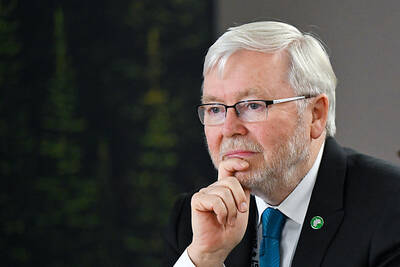A brutal week on Wall Street ended with the approval of a massive US government lifeline for the troubled financial sector, but investors are still searching for a reason to cheer.
The US$700 billion plan is expected to help start a recovery from a US housing meltdown, but some argue it’s not clear when a global credit crunch that is choking off economic activity will start to ease.
The huge bailout “should alleviate some of the stress that has been building up in the US financial markets over the past several weeks,” said Brian Bethune, economist at Global Insight. “However, it would be naive to assume that these measures alone will be a panacea for the economy. The economy is in the midst of a recession.”
The Dow Jones Industrial Average of 30 blue-chips plummeted 7.34 percent for the week to 10,325.38, including last Monday’s record loss of 777 points.
The broad-market Standard & Poor’s 500 index saw an even steeper loss of 9.39 percent for the week to 1,099.23 while the technology-heavy NASDAQ composite plunged 10.8 percent to 1,947.39.
The stomach-churning week on Wall Street came amid a further freeze-up of global credit markets, virtually shutting down interbank lending and threatening to further roil a weak economy.
“There is nearly an unbearable amount of fear and panic in the financial markets today. Indeed, for investors it seems in times like these there are few places to hide,” Scott Anderson at Wells Fargo Economics said.
Standard & Poor’s analysts said the freeze-up was a situation where “fear overtakes fundamentals.”
Some investors had pinned hopes on congressional approval of the financial rescue plan to help banks and other firms shed their distressed assets from the US real estate collapse. But even after the bill was passed, tensions remained high.
“The economy was toast without this package,” said John Ogg, an analyst at financial Web site 24/7 Wall Street.
“But the economy is still likely going to suffer and enter into a recession ... This bill may not be enough and it may already be too late,” Ogg said.
Peter Cohan, of the consulting firm Peter Cohan & Associates, said the plan leaves many questions unanswered.
“I think that unless the Treasury can solve the thorny problem of setting a price for the mortgage-backed securities (MBS) and collateralized debt obligations (CDOs), then it will fail to solve the real economic problem — which is a lack of trust in the financial system,” he said.
The market was reminded of a weak economy with data showing a loss of 159,000 jobs last month. Earlier in the week, data showed a sharp 4.0 percent slide in factory orders.
Further underscoring the economic malaise, US auto sales took a beating last month as the worsening economy turned dealer showrooms into ghost towns and major automakers reported sales drops of up to 37 percent.
“The question is no longer whether the economy is in a recession, but will it be a ‘lower-case’ recession or an ‘upper-case’ recession,” Ethan Harris at Barclays Capital said. “We now expect the latter.”
Amid the gloom, there was little room for optimism, but some analysts said the selling may have reached the point of climax.
“There are some truly compelling indications that the market is looking for a bottom that could put the lows in for some time,” said John Wilson, equity strategist at Morgan Keegan in a note to clients.
“It could take a few months to develop or it could be happening now. We won’t know until we have some hindsight, but I believe long-term investors (truly long-term investors) should be adding to stocks,” he said.
Bond prices gained over the week as investors flocked to safety. The yield on the 10-year Treasury bond eased to 3.644 percent from 3.827 percent a week earlier, and that on the 30-year bond fell to 4.123 percent from 4.357 percent. Bond yields and prices move in opposite directions.

NEXT GENERATION: The four plants in the Central Taiwan Science Park, designated Fab 25, would consist of four 1.4-nanometer wafer manufacturing plants, TSMC said Taiwan Semiconductor Manufacturing Co (TSMC, 台積電) plans to begin construction of four new plants later this year, with the aim to officially launch production of 2-nanometer semiconductor wafers by late 2028, Central Taiwan Science Park Bureau director-general Hsu Maw-shin (許茂新) said. Hsu made the announcement at an event on Friday evening celebrating the Central Taiwan Science Park’s 22nd anniversary. The second phase of the park’s expansion would commence with the initial construction of water detention ponds and other structures aimed at soil and water conservation, Hsu said. TSMC has officially leased the land, with the Central Taiwan Science Park having handed over the

The Philippines is working behind the scenes to enhance its defensive cooperation with Taiwan, the Washington Post said in a report published on Monday. “It would be hiding from the obvious to say that Taiwan’s security will not affect us,” Philippine Secretary of National Defense Gilbert Teodoro Jr told the paper in an interview on Thursday last week. Although there has been no formal change to the Philippines’ diplomatic stance on recognizing Taiwan, Manila is increasingly concerned about Chinese encroachment in the South China Sea, the report said. The number of Chinese vessels in the seas around the Philippines, as well as Chinese

URBAN COMBAT: FIM-92 Stinger shoulder-fired missiles from the US made a rare public appearance during early-morning drills simulating an invasion of the Taipei MRT The ongoing Han Kuang military exercises entered their sixth day yesterday, simulating repelling enemy landings in Penghu County, setting up fortifications in Tainan, laying mines in waters in Kaohsiung and conducting urban combat drills in Taipei. At 5am in Penghu — part of the exercise’s first combat zone — participating units responded to a simulated rapid enemy landing on beaches, combining infantry as well as armored personnel. First Combat Zone Commander Chen Chun-yuan (陳俊源) led the combined armed troops utilizing a variety of weapons systems. Wang Keng-sheng (王鏗勝), the commander in charge of the Penghu Defense Command’s mechanized battalion, said he would give

AUKUS: The Australian Ambassador to the US said his country is working with the Pentagon and he is confident that submarine issues will be resolved Australian Ambassador to the US Kevin Rudd on Friday said that if Taiwan were to fall to China’s occupation, it would unleash China’s military capacities and capabilities more broadly. He also said his country is working with the Pentagon on the US Department of Defense’s review of the AUKUS submarine project and is confident that all issues raised will be resolved. Rudd, who served as Australian prime minister from 2007 to 2010 and for three months in 2013, made the remarks at the Aspen Security Forum in Colorado and stressed the longstanding US-Australia alliance and his close relationship with the US Undersecretary